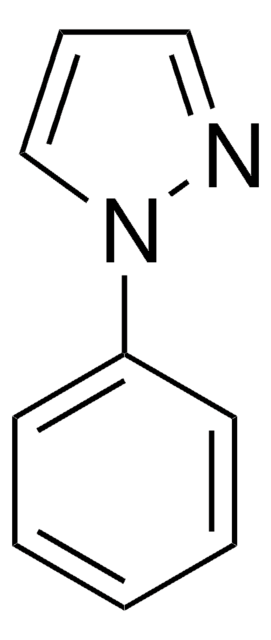All Photos(2)
About This Item
Empirical Formula (Hill Notation):
C15H11N
CAS Number:
Molecular Weight:
205.25
EC Number:
MDL number:
UNSPSC Code:
12352100
PubChem Substance ID:
NACRES:
NA.22
Recommended Products
Assay
99%
mp
84-85 °C (lit.)
functional group
phenyl
SMILES string
c1ccc(cc1)-c2ccc3ccccc3n2
InChI
1S/C15H11N/c1-2-6-12(7-3-1)15-11-10-13-8-4-5-9-14(13)16-15/h1-11H
InChI key
FSEXLNMNADBYJU-UHFFFAOYSA-N
Gene Information
rat ... Grin2b(24410)
General description
2-Phenylquinoline is the major quinoline alkaloid of Galipea iongiflora, a Bolivian plant used as treatment for cutaneous leishmaniasis. Antinociceptive properties of 2-phenylquinoline isolated from the bark of Galipea iongiflora against different models of pain in mice were evaluated.
Application
2-Phenylquinoline was used in quantitative structure-activity relationship (QSAR) analyses of estrogen receptor β-selective ligands.
Signal Word
Warning
Hazard Statements
Precautionary Statements
Hazard Classifications
Eye Irrit. 2 - Skin Irrit. 2 - STOT SE 3
Target Organs
Respiratory system
Storage Class Code
11 - Combustible Solids
WGK
WGK 3
Flash Point(F)
Not applicable
Flash Point(C)
Not applicable
Personal Protective Equipment
dust mask type N95 (US), Eyeshields, Gloves
Choose from one of the most recent versions:
Certificates of Analysis (COA)
Lot/Batch Number
Don't see the Right Version?
If you require a particular version, you can look up a specific certificate by the Lot or Batch number.
Already Own This Product?
Find documentation for the products that you have recently purchased in the Document Library.
Customers Also Viewed
F Campos-Buzzi et al.
Methods and findings in experimental and clinical pharmacology, 32(10), 707-711 (2011-01-13)
The present study evaluated the antinociceptive properties of an alkaloid extract and 2-phenylquinoline obtained from the bark of Galipea longiflora Krause (Rutaceae) against different models of pain in mice. The results demonstrate that the alkaloid extract caused a pronounced antinociceptive
Hye Jeong Yang et al.
Journal of ethnopharmacology, 208, 84-93 (2017-07-09)
Taraxacum coreanum Nakai has been traditionally used for treating inflammatory diseases including gastrointestinal diseases. We studied whether water extracts of Taraxacum coreanum Nakai (TCN) had a protective effect on acute and chronic gastritis induced by ethanol/HCl in an animal model
Balaji et al.
Journal of enzyme inhibition and medicinal chemistry, 26(6), 831-842 (2011-03-29)
Estrogen receptor beta (ERβ) selective ligands have attracted much attention recently in the design of anti-cancer drugs that are devoid of the common side effects of estrogen. Structural studies of estrogen receptor alpha (ERα) and β revealed that there were
Régis Carlos Benvenutti et al.
Journal of ethnopharmacology, 250, 112473-112473 (2019-12-15)
The species Urera baccifera (L.) Gaudich. ex Wedd. (Urticaceae) is native to the Americas and is distributed widely throughout Brazil, where it is known as urtiga-brava, urtiga-vermelha, or urtigão. The leaves are often used as anti-inflammatory and antirheumatic agents and
A Fournet et al.
Antimicrobial agents and chemotherapy, 40(11), 2447-2451 (1996-11-01)
The antileishmanial efficacies of 2-n-propylquinoline, chimanines B and D, 2-n-pentylquinoline, 2-phenylquinoline, 2-(3,4-methylenedioxyphenylethyl) quinoline, and two total alkaloidal extracts of Galipea longiflora were evaluated in BALB/c mice infected with Leishmania amazonensis or Leishmania venezuelensis. Animals were treated for 4 to 6
Our team of scientists has experience in all areas of research including Life Science, Material Science, Chemical Synthesis, Chromatography, Analytical and many others.
Contact Technical Service![Benzo[h]quinoline 97%](/deepweb/assets/sigmaaldrich/product/structures/344/715/928932d2-4ca4-4402-b56c-85a80100ce17/640/928932d2-4ca4-4402-b56c-85a80100ce17.png)











![11H-Benzo[a]carbazole](/deepweb/assets/sigmaaldrich/product/structures/391/065/abfb4cba-81ab-44b8-a816-d8791a903400/640/abfb4cba-81ab-44b8-a816-d8791a903400.png)

